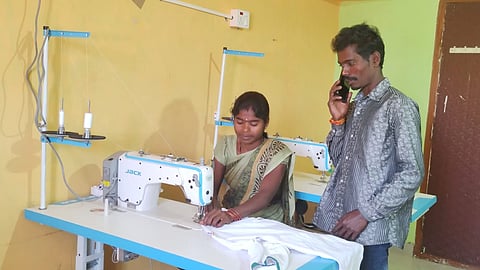

“I decided I don’t need to work for someone else. I can work for myself,” says Marappa, 38, with confidence. This is not just another entrepreneur speaking. Marappa has worked long, hard hours for around 4.5 years as a bonded labourer in a brick kiln in Karnataka’s Ramanagara district, around two hours from Bengaluru. Today, he heads Udyonmukha, an association of former bonded labourers that advocates for their rescue, rehabilitation, and welfare in the state. With February 9 being observed as Bonded Labour System Abolition Day since 2021 in Karnataka, Marappa has a packed month, participating in workshops and giving talks on bonded labour to panchayats, government departments, and law enforcement agencies.
Formed in 2019 with the support of non-governmental organisations, Udyonmukha has 127 members across Karnataka. The survivor-led association organises regular meetings, helps members access government schemes and rehabilitation packages, get identity proof documents, and addresses livelihood challenges.
Marappa’s wife Purnima, 27, runs a tailoring unit along with other former bonded labourers like her under the Udyonmukha Trust, in Kadasikuppa village in Ramanagara. The unit sells laptop, jewellery, and tote bags, cushion covers, and other home decor items. Animal rearing is another source of livelihood for many of Udyonmukha members. During Covid-19, the organisation’s leaders distributed ration kits and other necessities in their villages.
While many of the released labourers turn to daily wage work, Marappa had other ideas. He has leased a two-acre land growing sorghum, paddy, and other crops. “I have done all kinds of jobs around the village. This work is better. If I need extra help on the land, I hire people from the village,” he says.
The couple detail their life as bonded labourers. It was a loan of Rs 20,000 from the brick kiln owner for wedding expenses that got them trapped. They were promised Rs 300 for cutting 1,000 bricks when they joined. It entailed working seven days a week, from around 5.30 am to around 7 pm. The six families (most related to each other) were not allowed outside the factory premises at all, except once a week when one person from each family could go to the nearby market to get groceries. “There were no rest days… even if we were ill,” says Marappa.
The actual wages the couple received during the entire period was Rs 500-1,000 a week to manage expenses, apart from the initial loan of Rs 20,000. “At one point, we had cut 10,000 bricks in a week but there was zero accounting. A rainy day can wash out entire days’ work,” says Marappa.
“There were times when we worked whole nights as well. But still we didn’t get time off the next day. Once during a festival, we tried to escape. But the owner found us at Purnima’s house and brought us back. He would regularly threaten all of us, abuse us physically and verbally,” he recalls. When Purnima’s parents offered to repay the loan for their release after four years of captivity, Marappa was told that the outstanding amount was now Rs 1.5 lakh – a sum they could ill afford.
Purnima remembers the difficulties she faced during the pregnancy and delivery of both her children. There were hardly any prenatal checkups and she had to return to work two months after the children were born. “I used to put my children on a mat at the factory and continue working,” she says. Marappa’s sister had a worse fate. Purnima says her foetus was dead in the womb for a week before she could access medical care.
The families were finally released in 2014 after a tip-off. When the owner was convicted in 2017, it made headlines for the short turnaround time, and it was believed to be the first conviction under Section 370 of the IPC for a bonded labour trafficking case in Karnataka.
In Karnataka, which ranks among states with the highest number of bonded labourers, data shared by the state’s Panchayat Raj Commissionerate shows that between 2001 and 2010, a total of 65,762 persons were released. And since May 2016, a total of 2,562 persons, including 107 children, were released. Of this, 1,792 people are native to Karnataka. Bengaluru Urban, Chikkaballapur, Hassan, Mysuru, and Mandya are districts with the highest cases of bonded labour.
Priyanka Francis, Commissioner, Karnataka Panchayat Raj Commissionerate, says bringing on board stakeholder departments like Labour, Revenue, Rural Development, and Panchayat Raj, and forming vigilance committees is crucial. “We identify frontline officers in different departments,” she says, adding that survivors are given priority in housing, education, and skill development.
“Nobody else should suffer this,” declares Marappa, saying he gained courage and confidence to take on the injustice of bonded labour following his testimonials in court and his work with Udyonmukha. In 2016, the Union government had put the estimated number of bonded labourers in India at 1.84 crore, with an aim to halve it by 2023-24 and bring it down to nil by 2030. But a 2023 Lok Sabha report shows that goal is far away. Perhaps the survivor-led approach by organisations like Udyonmukha offers a solution for India’s bonded labour crisis.
Annie Philip is an independent journalist based in Bengaluru.